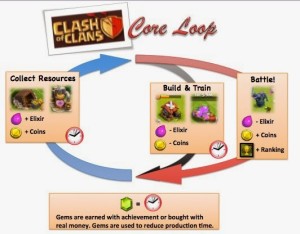Entice Me Back: How Core Loops drive Re-Engagement
If you’re anything like me, you try out a lot of new games, apps & services – but only stick with a few. Why is that? How do digital services entice us back, over and over again? What does it take to turn a one-time experience into a habit?
For each of us, the answer is deeply personal. We become habitual users of games, apps and services when they hit that singular “sweet spot” of opportunity, need fulfillment and social context. My son, for example, NEEDED to be on Myspace, then Facebook – and now Snapchat. His daily habits were formed – then broken & re-formed – as his tribe migrated.
My Mom tried repeatedly to use Facebook, but couldn’t deal with the spam and visual chaos. So she retreated to her daily email ritual, where she and her friends exchange witty thoughts and photos of their grandkids via mailing lists.
 My daughter plays Minecraft daily to try out what she learns from Stampy Longhead, her favorite Youtube star. She swaps Minecraft tips during playdates. and is in high demand for tutorial walkthroughs among the first graders.
My daughter plays Minecraft daily to try out what she learns from Stampy Longhead, her favorite Youtube star. She swaps Minecraft tips during playdates. and is in high demand for tutorial walkthroughs among the first graders.
And me? I recently swore off Candy Crush (too damn addictive). Now I take daily “watercooler breaks” on Twitter to swap links, ideas and witty repartee with folks I like and admire. My carefully curated, highly personal feed gives me something quick, pleasurable and interactive to do when I need a break from daily life.
Twitter, Facebook, Instagram, Minecraft, Candy Crush, Clash of Clans – all these habit-forming systems are built around a compelling feedback loop with a pleasurable, repeatable activity at it’s core. These Core Loops (AKA Ga me Loops, Compulsion Loops, Habit Loops, Activity Loops, Engagement Loops) are widely used in gaming and elsewhere to model players’ action chains and in-game progression.
me Loops, Compulsion Loops, Habit Loops, Activity Loops, Engagement Loops) are widely used in gaming and elsewhere to model players’ action chains and in-game progression.
A well-crafted Core Loop is essential for great gameplay – and in sophisticated games, these loop systems can get quite complex. For example, this excellent analysis of Clash of Clans illustrates how core loops, double loops, nested loops, and micro-loops that all work together to make that game so compelling to play. If you want to understand loop design in online games, this article is great background reading.
Every complex system starts out as a simple system that works – and then evolves. Don’t let complexity scare you off – not every app needs the inter-connected loop system of a free-to-play strategy game.
To entice your players back, start by crafting and tuning a simple, solid Core Loop based around three key design rules:
- start with COMPELLING ACTIVITIES players want to do repeatedly
- create a mix of FEEDBACK and PROGRESS to increase players’ skill, motivation and flow
- develop an integrated system of TRIGGERS and INVESTMENT to pull players back
In my next 3 posts, I’ll explain these design rules in more detail, illustrated with examples from Minecraft, Lumosity, Duolingo, Facebook. Twitter, Instagram, and Clash of Clans. In the meantime, please share your thoughts & questions in the comments – I’d love to know if you do something similar in your own work.

3 Questions That Will Help You Make a More Engaging Experience | Felipe Lara Creative Direction
November 30, 2016 @ 4:06 pm
[…] If you want to go a little deeper on how these 3 rules work in different loops, take a look Amy Jo Kim’s article here. […]
Major behavioral theories, explained | by Irina - BestBlog
May 2, 2021 @ 12:13 pm
[…] a habit. Similar models are suggested by Charles Duhigg in his book “The Power of Habit” and by Amy Jo Kim with her engagement loop that we have reviewed Gamification […]